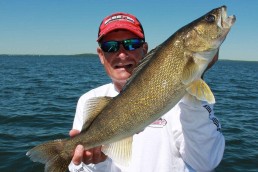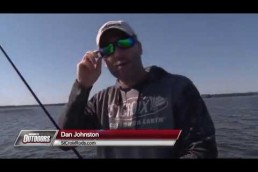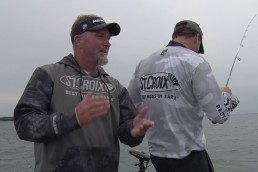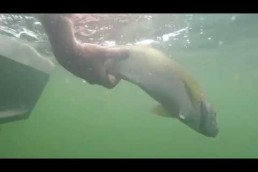Mille Lacs Lake Forecast
SHARE THIS POST
Despite some doom and gloom in recent years, folks in touch with the pulse of the Lake Mille Lacs fishery are excited for the coming walleye season. If you were one of the folks on the ice-up there this winter catching lots of 12- to 14-inch eaters and hooked one of the big walleyes in Mille Lacs, you have an idea of what’s in store once we hit mid-May. Those little eaters will be 15 inches or more by early summer.
An incredibly dynamic lake, perhaps no other Minnesota walleye factory bounces back more quickly from the many varied outside pressures placed on it by folks not in touch with the pulse of the Mille Lacs fishery.
Lake Mille Lacs is my “home” lake; it’s one of many awesome fisheries in Minnesota I enjoy fishing in all seasons and it’s less than 90 minutes from home. It tugs at my heart and shirtsleeves most often and says “get up here and fish.”—I rarely need any additional persuading.
This 132,000-acre multi-species mecca is one of Minnesota’s premier fishing gems. But in an odd twist, it receives the bulk of its angling pressure from Minnesota residents rather than outstate anglers. Many avid fishermen from Wisconsin, Iowa, Illinois, and other states drive right by Mille Lacs (or pass 30 minutes to the east when heading up I-35) en route to other destinations. True, there are many great fisheries to the north; also true, Mille Lacs Lake does not provide the “classic northwoods experience,” in terms of stunning topography like towering pines and granite shorelines. These types of experiences are best found in the national parks, the border waters and points farther north into Ontario. In terms of overall walleye numbers with a legitimate shot at trophy fish, Mille Lacs may be second to only Lake of the Woods.
An early ice-out and warm spring bode well for Mille Lacs Lake. By the opener, the walleyes will be well past the spawn and the early summer feeding frenzy will be cranking up. Local guides are predicting potential 40- to 60-fish days, and on the larger charter launches with more lines in the water, 100-plus fish outings won’t raise an eyebrow. Sure, there will be a lot of “throw-backers,” but let’s be realistic, given the time and expense invested, the era of justifying the experience by how many fish you get to keep are a thing of the past. If you catch and release a few dozen fish, are you really disappointed if you only keep two walleye fillets, versus four or six? Enjoying a meal of fish is a wonderful part of the outdoor experience, but by no means should it be considered the endgame. Give me lots of bites, steady action, happy kids and adults alike and that’s a great day on the water.
As far as walleye-catching tactics, pick your favorite method. While a cold-water opener at 50 degrees can limit your options to “fish slowly” and “fish more slowly” to entice sluggish post-spawn walleyes to bite, presumably by mid-May this year the surface temps will be be brushing the mid-60s, so expect any number of presentations to catch their share of fish.
Walleye angling techniques such as refined live-bait rigging, slip bobber fishing and spinner/’crawler rigs were perfected on Mille Lacs years ago, and continue to lead the way as productive tactics. If you enjoy trolling crankbaits, warmer water means more consistency with lures, and you can catch some Mille Lacs monsters by trolling the open basin with leadcore tactics.
Are you enjoying this post?
You can be among the first to get the latest info on where to go, what to use and how to use it!
Other tactics include jigging weedlines or along rocky or sandy shorelines—especially in spring—or drifting live-bait rigs or spinners across flats on windy days. Anglers use drift socks—sometimes combined with a trolling motor or kicker motor thrust—to keep boat speed in tune with hungry walleyes. Live-bait rigs (ideal for working the edges of the main lake mudflats) present most effectively at speeds of .4 to .7 mph, while spinners are ideally suited for speeds of 1.0-1.2 mph.
Depending on how the structure lays out, based on wind direction and speed it’s sometimes best to slide downwind and use drift socks and motors to brake to achieve the desired presentation for speed. In calmer waters, running crosswind or even pushing into the wind is the preferred boat-control tactic. Control-drifting live bait or spinners is a primary way to fish Mille Lacs’ expansive gravel flats, some of which run for a 1/2-mile or more at consistent depths of 26 to 30 feet.
Wind also brings out the slip bobbers. Rough or overcast conditions disorient bait on shallow reefs and the walleyes shift into a high-gear feeding mode. Slip bobber anglers tip either a small lead head jig ( at 1/32 or 1/16 ounces) or a plain hook with a leech and position the bait on flat spots on the reefs from 6 feet down to 18 to 20 feet. Often, once walleyes are contacted in a certain depth, you can be sure multiple reefs on the lake can produce fish from these depths, provided weather conditions don’t change dramatically. Bobber fishing also remains a key nighttime tactic on Mille Lacs throughout the open-water season.
Expect to catch lots of 14- to 16-inch walleyes when you venture to Mille Lacs this May and June. But, also know that Mille Lacs is one of Minnesota’s best lakes to give you a shot at a trophy walleye of 28 inches or larger. And, the number of 20- to 26-inch fish is excellent as well.
MWO
SHARE THIS POST
Did you enjoy this post?
You can be among the first to get the latest info on where to go, what to use and how to use it!



